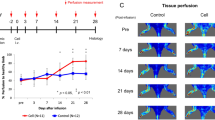Abstract
Purpose
Angiogenesis plays a major role in various physiological and pathological situations. Thus, an angiogenic therapy with vascular endothelial growth factor (VEGF) has been commonly recommended as a representative therapeutic solution to recover the insufficient blood supply of collateral vessels in an ischemic lesion. In this study, the injection method and injection time point of VEGF proteins were focused to discover how to enhance the angiogenic effect with VEGF.
Methods
Mouse models (n = 15) were divided into control, VEGF treatment by intra-venous injection (VEGF-IV) and VEGF treatment by intra-muscular injection (VEGF-IM). Right proximal femoral arteries of mice were firmly sutured to obstruct arterial blood-flow. In the VEGF-IV treatment group, VEGF proteins were injected into the tail vein and, in the VEGF-IM treatment group, VEGF proteins were directly injected into the ischemic site of the right thigh after postoperative day 5, 10, 15, 20 and 25 follow-ups. Blood-flow images were acquired by 99mTc Gamma Image Acquisition System to compare the ischemic-to-non-ischemic bloodstream ratio at postoperative days 5, 15, and 30.
Results
VEGF-IM treatment significantly induced higher an angiogenic effect rather than both the control group (P = 0.008) and VEGF-IV treatment group (P = 0.039) at the 30th day.
Conclusion
During all experiments, angiogenesis of VEGF-IM treatment represented the most evident effect compared with control and VEGF-IV group in a mouse model of hindlimb ischemia.




Similar content being viewed by others
References
Al SH. Therapeutic angiogenesis in cardiovascular disease. J Cardiothorac Surg. 2007;2:49.
Ahn SH, Min SI, Kin SY, Min SK, Yang HK, Kim SJ, et al. Effect of nanoparticle with VEGF in mouse ischemic hindlimb model. J Korean Surg Soc. 2010;79:294–9.
Wahlberg E. Angiogenesis and arteriogenesis in limb ischemia. J Vasc Surg. 2003;38:198–203.
Hoeben A, Landuyt B, Highley MS, Wildiers H, Van Oosterom AT, De Bruijn EA. Vascular endothelial growth factor and angiogenesis. Pharmacol Rev. 2004;56:549–80.
Biscetti F, Straface G, Arena V, Stigliano E, Pecorini G, Rizzo P. Pioglitazone enhances collateral blood flow in ischemic hindlimb of diabetic mice through an Akt-dependent VEGF-mediated mechanism, regardless of PPARγ stimulation. Cardiovasc Diabetol. 2009;8:49.
Zhu WH, Maclntyre A, Nicosia RF. Regulation of angiogenesis by vascular endothelial growth factor and angiopoietin-1 in the rat aorta model. Am J Pathol. 2002;161(3):823–30.
Yamada K, Ushio Y, Hayakawa T, Kalo A, Yamada N, Mogami H. Quantitative autoradiographic measurements of blood–brain barrier permeability in the rat glioma model. J Neurosurg. 1982;57:394–8.
Falcon BL, Barr S, Gokhale PC, Chou J, Fogarty J, Depeille P, et al. Reduced VEGF production, angiogenesis, and vascular regrowth contribute to the antitumor properties of dual mTORC1/mTORC2 inhibitors. Cancer Res. 2011;71(5):1573–83.
Baelde HJ, Eikmans M, Lappin DW, Doran PP, Hohenadel D, Brinkkoetter PT, et al. Reduction of VEGF-A and CTGF expression in diabetic nephropathy is associated with podocyte loss. Kidney Int. 2007;71(7):637–45.
Jośko J, Gwóźdź B, Jedrzejowska-Szypułka H, Hendryk S. Vascular endothelial growth factor (VEGF) and its effect on angiogenesis. Med Sci Monit. 2000;6(5):1047–52.
Lee YS. Radiopharmaceuticals for molecular imaging. Open Nucl Med J. 2010;2:178–85.
Min JJ. Monitoring gene therapy by radionuclide approaches. Nucl Med Mol Imaging. 2006;40(2):96–105.
Acknowledgments
This study was supported by the Radiation Technology R&D program through the National Research Foundation of Korea Grant funded by the Ministry of Education, Science and Technology (2012-M2A2A7035779, 2011-0028581, 2009-0078422) and Research Funds of Chonbuk National University in 2012.
Conflicts of Interest
Tai Kyoung Lee, Chang-Moon Lee, Hyosook Hwang, Kyung Sook Na, JeongIl Kwon, Hwan-Seok Jeong, Philsun Oh, Hee Kwon Kim, Seok Tae Lim, Myung-Hee Sohn, and Hwan-Jeong Jeong declare that they have no conflict of interest.
Ethical Statement
This study was approved by the animal ethics committee in our hospital and was performed in accordance with the ethical standards laid down in the 1964 Declaration of Helsinki and its later amendments.
Author information
Authors and Affiliations
Corresponding author
Rights and permissions
About this article
Cite this article
Lee, T.K., Hwang, H., Na, K.S. et al. Effect of Angiogenesis Induced by Consecutive Intramuscular Injections of Vascular Endothelial Growth Factor in a Hindlimb Ischemic Mouse Model. Nucl Med Mol Imaging 48, 225–229 (2014). https://doi.org/10.1007/s13139-014-0273-5
Received:
Revised:
Accepted:
Published:
Issue Date:
DOI: https://doi.org/10.1007/s13139-014-0273-5




